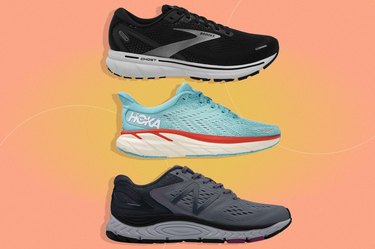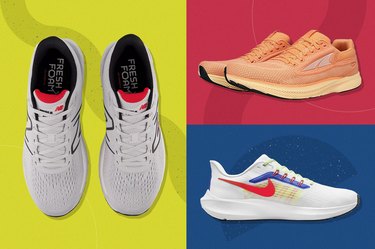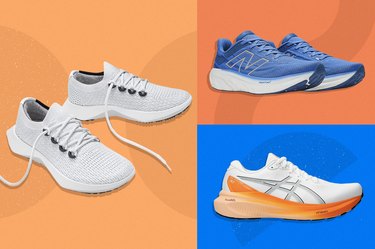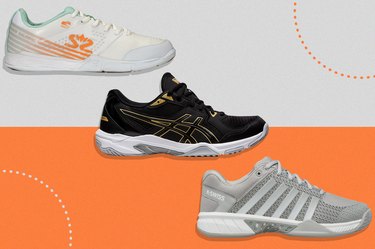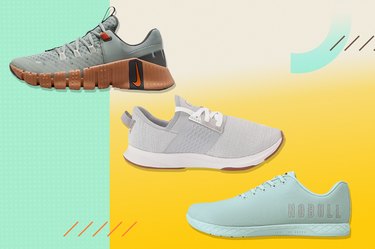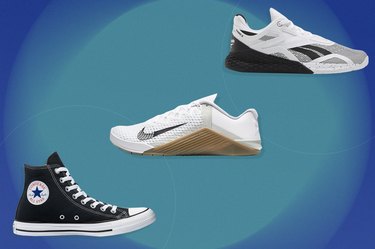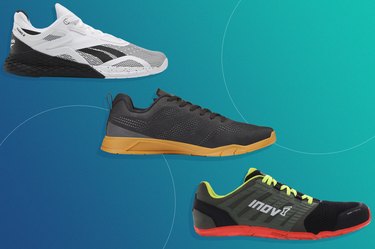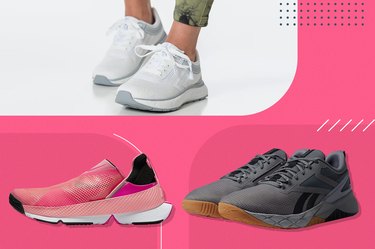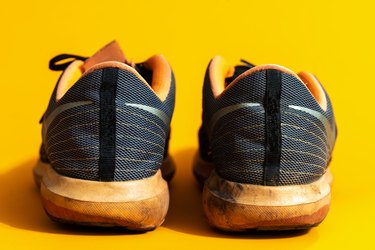
Depending on the shoes you're wearing, with each step in your favorite workout, you'll either feel a cloud of comfort — or discomfort. This begs the question: Is it time for new workout shoes? Are you even wearing the right shoes?
Here are some telltale signs to look for to help you determine the answers to these questions.
Video of the Day
Video of the Day
1. You've Worn Them for 300 to 500 Miles or 40 to 60 Hours
The usual lifespan for a running or walking shoe is about 300 to 500 miles, according to Alicia Canzanese, DPM, the vice president of the American Academy of Podiatric Sports Medicine.
She says for gym or "court-sport" sneakers, such as pickleball shoes, tennis shoes or footwear for basketball, the gauge is different. "The general rule of thumb is 40 to 60 hours of playing a sport in the shoe."
That means if you're playing in those shoes more than a couple times a month, the answer to how often you should replace your shoes is around every 9 to 12 months, she says.
Elite trail and ultra runner Lindsey Herman, founder of Running Wild LLC, says she uses the mobile app Strava to track her shoes' mileage. Strava alerts her when she reaches 250 miles so she can start looking for new running shoes. Other apps offer similar gear tracking, including ShoeCycle and Garmin Connect.
"Something I've learned is I should not get to the point where I can tell they've reached their limit," Herman says.
2. You're Experiencing Aches and Pains
As your footwear weathers, you might start to notice discomfort in different parts of your body.
In general, the shoe may lose its shock absorption first, Dr. Canzanese says. "You might feel some achiness in the joints or discomfort overall, like you've lost some of the cushioning."
She says specific places you may feel discomfort include:
- Knees
- Ankles
- Hips
- Joints at the base of the toes (most commonly in your big toes)
Frequent blisters may also be a sign it's time for new shoes — or that you didn't have the right fit to begin with. (More on that below.)
3. Cosmetic Wear and Tear Are Taking Over
When you first buy training shoes, you might obsess over how flashy they look. However, fast-forward a few weeks or months, and they may start to look tired.
Keep an eye on the shoes' treading, similar to a car tire, Dr. Canzanese says. "If you look at the bottom of your shoes and the tread's really worn out or starting to go flat, that's generally a sign you needed a new shoe a long time ago!"
The midsole of the shoe typically begins to wear out first, she says. You can check it by squeezing the shoe to see if there are small cracks or indentations along the midsole. "If you do that, and you're really seeing a lot of those lines, often that's a sign you've lost that shock absorption."
Herman agrees you should try to avoid letting your shoe get to that point. "If you start having visible wear and tear on the shoes, I think it's too late," she says.
That said, if you don't have room in your budget for new shoes, don't toss your current pair just yet. Research on injuries from running in old sneakers is limited and inconclusive, but it may throw off your individual running mechanics, which could contribute to injuries.
How to Find the Right Fit
If these signs you need new workout shoes sound familiar, it's time to pick out a fresh pair. So, where do you start?
If your foot hasn't been measured in a few years, revisit your shoe size first. "It's not unusual for your foot size to change as you age," Dr. Canzanese says.
She recommends trying on sneakers with the workout socks you plan to wear with them to make sure everything feels comfortable.
"If you feel like you have to work hard to break in your shoe, that shoe doesn't fit you, because they generally should feel pretty comfortable," Dr. Canzanese says.
Look for a shoe suitable for the sport you're participating in if you're doing it several times a week, according to the American Podiatric Medical Association. For example, if you're a distance runner, select an appropriate shoe designed to support your high mileage.
Then, go with what feels good. "I think the athlete really needs to [pick a shoe] based on comfort, not based on the specs of how they think a shoe is going to perform," Herman says. "Ultimately, the athlete is going to perform their best if they're the most comfortable."
How to Make Your Shoes Last Longer
The best way to lengthen the life of your workout shoes is to rotate through a few different pairs at once.
While it may be tempting to pick one comfortable shoe and buy a few different pairs, that's not the goal here, says Blake Dircksen, PT, DPT, CSCS, a physical therapist at Bespoke Treatments in New York and avid runner. Instead, lean into different styles for different workouts or sports.
For runners, for example, that might look like the following, he says: "Think of getting one for base mileage and easy recovery days, one for your faster track or interval workouts and perhaps another style for long runs. Each of these styles will help you perform better in that particular workout — which will help you avoid overuse injuries."
